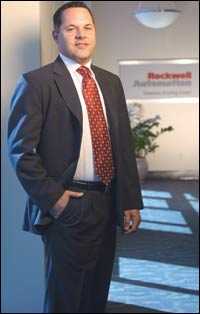Corporate legal departments leading the digital charge
By: Jane Pribek//September 19, 2011//

When Milwaukee-based Rockwell Automation Inc. decided to retool the way it organized important documents, it was the company’s legal, not information technology, department that led the charge.
The company’s new document management system not only alleviates the disorganization that plagued the department before, but also resulted in less paper wasted as more documents are filed digitally, said John Miller, Rockwell’s vice president and chief intellectual property counsel.
The legal department at New Berlin-based Decision Insight Information Group also is pushing toward a digitally organized, paperless future, said Joshua Laterman, general counsel.
“I think the modern (legal) department, if it’s going to be run like a business operation, needs to match quantitative analysis with the general counsel’s experience and intuition,” Laterman said. “And for qualitative data, you need to be paperless. You can’t create flow charts or pie diagrams for board presentations based on gathering up your papers.”
The switch makes hard data more readily available for decision making, he said, and should create more uniformity within the company’s contracts.
“The job is on me to show the value we create,” Laterman said, “and to be able to provide an accounting for the work we do and the dollars we spend.”
Going digital is helping both companies streamline, but the process is not always easy. As Miller and Laterman reflected on their experiences thus far, they noted instances when other companies could avoid pitfalls on the path to a digital future.
Getting started
A critical first step, both said, is selecting software and a vendor.
Rockwell’s IP team already used Microsoft SharePoint collaboration software, Miller said, and had positive experiences with it, so that seemed like the best route. Rockwell then opted to work with Brookfield-based Concurrency, a Microsoft technology consulting company, in part because it is local, he said.
SharePoint lets employees create libraries and document sets for individual matters, Miller said. It also associates metadata within files, making documents easier to find within the system.
The collaborative software walks the user through closing a matter once it’s completed, he said, in accordance with the document retention policy. That way, although some portions might be deleted, critical documents are preserved in an electronic records center.
Laterman said he was looking at two platforms for Decision Insight Information Group: TyMetrix, for matter management and to track outside legal billing; and Selectica, contract management software. Both are a reflection of his department’s workload, he said, where contract review is a central task.
Another important decision Miller and Laterman tackled in the early stages was what to do with old files. Rockwell opted to archive critical information from old files, such as documents memorializing major deals, settlements and other orders from litigation. It was helpful that the company already had a document retention policy in place, Miller said.
Still in the early stages of his department’s conversion, Laterman said he anticipated they would opt to go paperless just for open and future matters initially, and then gradually bring older data into the system.
Lessons learned
All told, it took about seven months to put Rockwell’s system in place, Miller said. The process could’ve gone faster, he said, but along the way they determined they needed to find outsourced server space, which added some time to the process.
The company plans to bring data back to an internal server within the next year, he said, for added cost-cutting and security.
Rockwell is about halfway through the process of migrating documents to the new system, Miller said, and within the next year, plans to have all documents there. The company is considering using temporary help with the process, he said.
Looking back, Miller said, he now realizes how important it was to get support for the project from the department leaders. Their endorsement and leadership helped when some employees questioned the changes, he said.
“There’s all different ways that people manage their workloads, and asking them to change and become part of a larger environment required them to change some of the ways they did things,” Miller said. “And that, surprisingly, was a little more difficult than we initially realized.
“None of the changes were flat-out rejected, but you could see some were questioning, ‘What’s the value of this?’”
With the support of other company leaders, Miller said, Rockwell employees are adapting to the new system.
“Now they’re starting to see the benefits,” he said, “when they’re here or when they’re working from a remote location.”
Paperless tips from the pros
The most significant barrier to creating a paperless environment might be you.
Not everyone is a candidate for going paperless, said Sarit Singhal, president of Superior Support Resources Inc. in Brookfield, because ditching old ways requires commitment.
Those interested in switching must have the discipline, he said, to scan every piece of paper that comes in and store it according to a departmentwide document management system. If you won’t do that when the workloads get high, don’t bother, he said.
But for those who switch, front-end costs can be recouped relatively quickly, Singhal said. He recently worked with an accounting firm that was spending as much as $30,000 annually to store files. After comparing costs, the firm realized they’d recoup the expense of going paperless in less than two years, Singhal said.
Most law firms and legal departments in Wisconsin aren’t ready, said Shawn Olley, president of Midwest Legal and eData Services Inc., Oak Creek. But many are starting down that path.
“Paperless is the way to go,” she said. “And those who have done it, even partially, love it. No one’s ever gone back to the old system — and they’re amazed at the time they can save not looking for something.”
Thinking of making the switch? Here are some things to consider:
What you’ll need
For hardware, you need scanners, either desktop or network, and some copiers can scan as well. You also need a software package with optical character recognition, which converts document images into an editable format and indexes folders and documents. If collaboration is important, you’ll need software with that capability.
In addition, you’ll need server space or some other solution for storing the data. Online storage is an emerging solution, Singhal said, but security is a critical concern, and consumers should do some due diligence to ensure their provider has taken steps to ensure the data is secure. Dropbox, for example, is a popular option, but recently it was hacked.
What it costs
At the most basic level — a one-attorney legal department with no staff — the hardware and software costs less than $500, Singhal said. The larger the department, the more variables are presented, though, such as leasing copiers versus buying scanners.
Key factors affecting cost include the volume of documents that will be scanned and the expertise of the people scanning them, Olley said.
But probably the most important decision with regard to cost, she said, is whether to convert old documents to digital. Archiving old files can ratchet up the costs, she said.
Olley estimates it typically costs about $300 for her firm to sort through a client’s box of materials, scan what’s important and shred the rest.
Who should be involved
That depends on the size of the legal department and the company, Singhal and Olley agreed. Both said they often worked with teams consisting of lawyers, information technology and risk managers, with one person designated as the leader who would see the project through.
How long it takes
This can vary, Olley said, depending on the size of the department, how long it and the company have existed and how organized their offsite documents are.
If going paperless from the present day forward, only, the switch can be made quickly, she said. Singhal said he has seen departments make the switch in two months and up to two years for more complex systems.
More from Corporate Counsel
- Business background bolsters Redding’s role
- What rainmakers know about persistence
- LAWBIZ COACH’S CORNER: In-house counsel should be prepared
- Corporate legal departments leading the digital charge
- LEGAL CENTS: Five ways to save with litigation management
- Etiquette drives success when responding to requests for proposals
Legal News
- Former Wisconsin college chancellor fired over porn career is fighting to keep his faculty post
- Pecker says he pledged to be Trump campaign’s ‘eyes and ears’ during 2016 race
- A conservative quest to limit diversity programs gains momentum in states
- Wisconsin prison inmate pleads not guilty to killing cellmate
- Waukesha man sentenced to 30 years for Sex Trafficking
- 12-year-old shot in Milwaukee Wednesday with ‘serious injuries’
- Milwaukee man convicted of laundering proceeds of business email compromise fraud schemes
- Giuliani, Meadows among 18 indicted in Arizona fake electors case
- Some State Bar diversity participants walk away from program
- Wisconsin court issues arrest warrant ‘in error’ for Minocqua Brewing owner
- Iranian nationals charged cyber campaign targeting U.S. Companies
- Facing mostly white juries, are Milwaukee County defendants of color truly judged by their peers?
WLJ People
- Power 30 Personal Injury Attorneys – Russell Nicolet
- Power 30 Personal Injury Attorneys – Benjamin Nicolet
- Power 30 Personal Injury Attorneys – Dustin T. Woehl
- Power 30 Personal Injury Attorneys – Katherine Metzger
- Power 30 Personal Injury Attorneys – Joseph Ryan
- Power 30 Personal Injury Attorneys – James M. Ryan
- Power 30 Personal Injury Attorneys – Dana Wachs
- Power 30 Personal Injury Attorneys – Mark L. Thomsen
- Power 30 Personal Injury Attorneys – Matthew Lein
- Power 30 Personal Injury Attorneys – Jeffrey A. Pitman
- Power 30 Personal Injury Attorneys – William Pemberton
- Power 30 Personal Injury Attorneys – Howard S. Sicula







